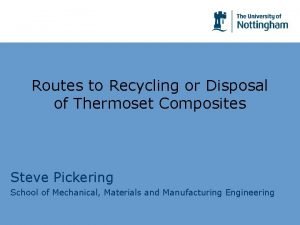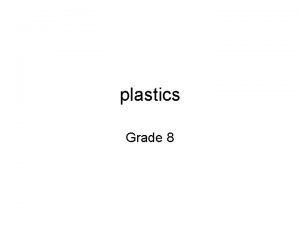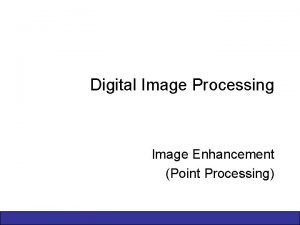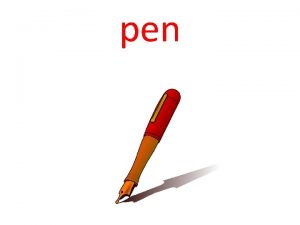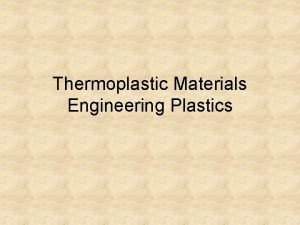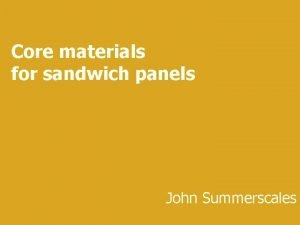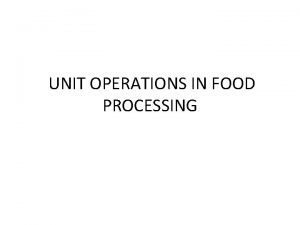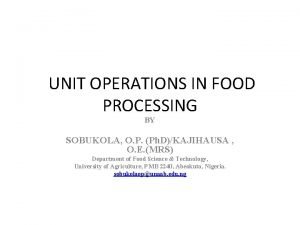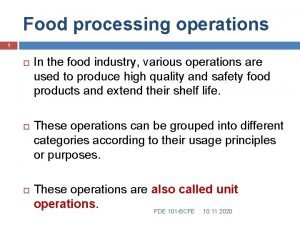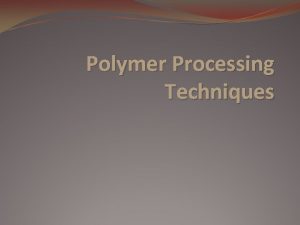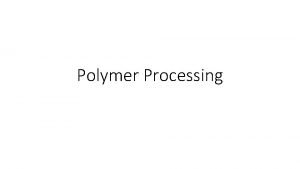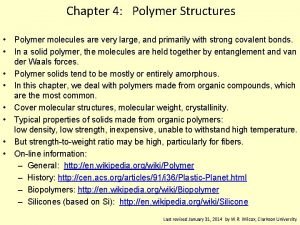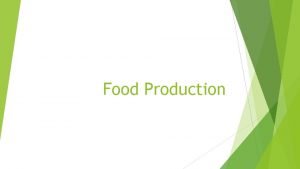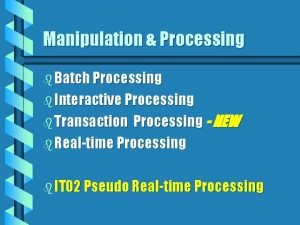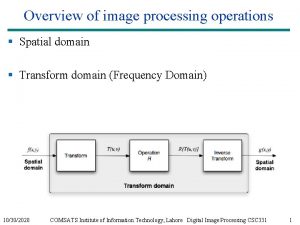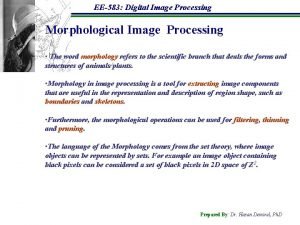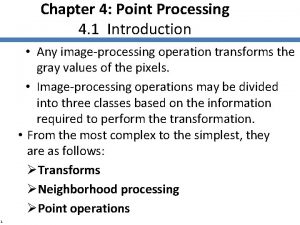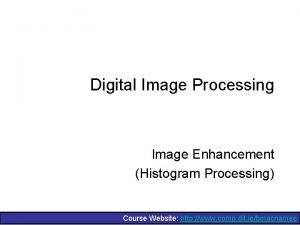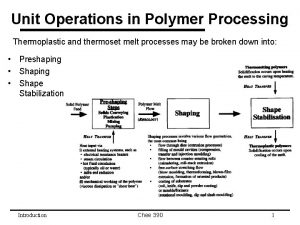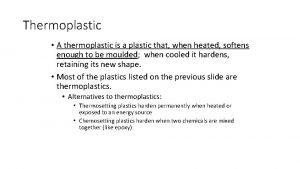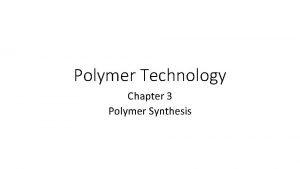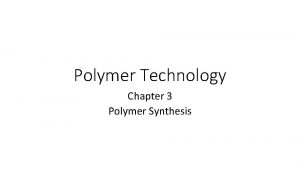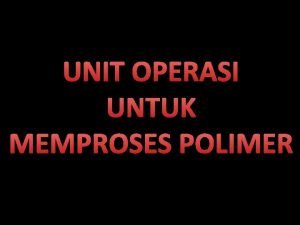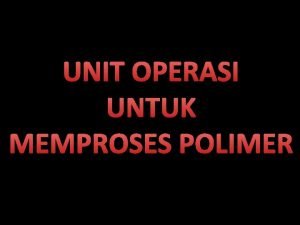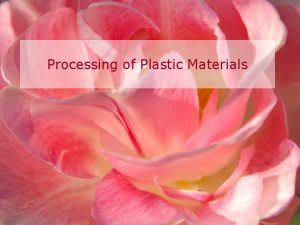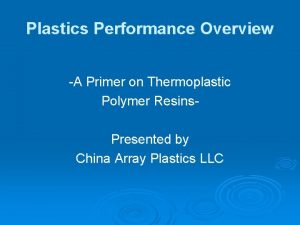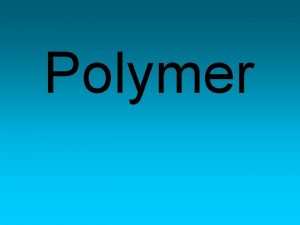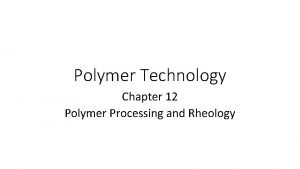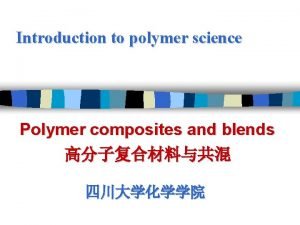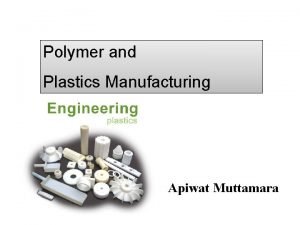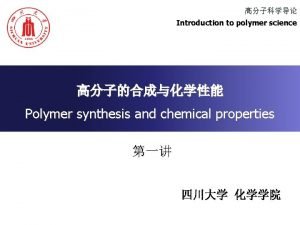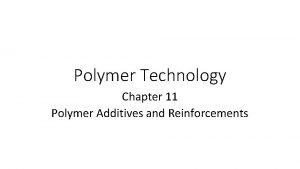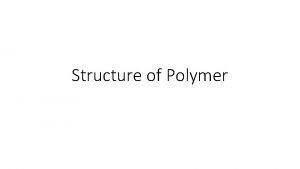Unit Operations in Polymer Processing Thermoplastic and thermoset























- Slides: 23

Unit Operations in Polymer Processing Thermoplastic and thermoset melt processes may be broken down into: • Preshaping • Shape Stabilization Introduction Chee 390 1

Unit Operations in Polymer Processing • Preshaping steps: – Solids handling and conveying: most processes usually involve feed in particulate form – Plastication: The creation of a polymer melt from a solid feed. – Mixing: often required to achieve uniform melt temperature or uniform composition in compounds – Pumping : The plasticated melt must be pressurized and pumped to a shaping device • Shaping: The polymer melt is forced through the shaping devices to create the desired shape. Ø The flow behavior (rheology) of polymer melts influences the design of the various shaping devices, the processing conditions and the rate at which the product can be shaped. • Shape stabilization: – Involves the solidification of the polymer melt in the desired shape, through heat transfer Introduction Chee 390 2

The Single Screw Plasticating Extruder • • Regions 1, 2, 3: Handling of particulate solids Region 3: Melting, pumping and mixing Region 4: Pumping and mixing Regions 3+4: Devolatilization (if needed) Introduction Chee 390 3

Product Shaping / Secondary Operations EXTRUSION Final Product (pipe, profile) Shaping through die Secondary operation ØFiber spinning (fibers) ØCast film (overhead transparencies, ØBlown film (grocery bags) Preform for other molding processes ØBlow molding (bottles), ØThermoforming (appliance liners) ØCompression molding (seals) Introduction Chee 390 4

Annular (Tubular) Dies In a tubular die the polymer melt exits through an annulus. These dies are used to extrude plastic pipes. The melt flows through the annular gap and solidifies at the exit in a cold water bath. Introduction Chee 390 5

Profile dies Profiles are all extruded articles having cross-sectional shape that differs from that of a circle, an annulus, or a very wide and thin rectangle (such as flat film or sheet) To produce profiles for windows, doors etc. we need appropriate shaped profile dies. The cross-section of a profile die may be very complicated Introduction Chee 390 6

Secondary Shaping Secondary shaping operations occur immediately after the extrusion profile emerges from the die. In general they consist of mechanical stretching or forming of a preformed cylinder, sheet, or membrane. Examples of common secondary shaping processes include: • Fiber spinning • Film Production (cast and blown film) Introduction Chee 390 7

Fiber Spinning Fiber spinning is used to manufacture synthetic fibers. A filament is continuously extruded through an orifice and stretched to diameters of 100 mm and smaller. The molten polymer is first extruded through a filter or “screen pack”, to eliminate small contaminants. It is then extruded through a “spinneret”, a die composed of multiple orifices (it can have 110, 000 holes). The fibers are then drawn to their final diameter, solidified (in a water bath or by forced convection) and wound-up. Introduction Chee 390 8

Fiber Spinning • Melt spinning technology can be applied to polyamide (Nylon), polyesters, polyurethanes and polyolefins such as PP and HDPE. • The drawing and cooling processes determine the morphology and mechanical properties of the final fiber. For example ultra high molecular weight HDPE fibers with high degrees of orientation in the axial direction have extremely high stiffness !! • Of major concern during fiber spinning are the instabilities that arise during drawing, such as brittle fracture and draw resonance. Draw resonance manifests itself as periodic fluctuations that result in diameter oscillation. Introduction Chee 390 9

Cast Film Extrusion • In a cast film extrusion process, a thin film is extruded through a slit onto a chilled, highly polished turning roll, where it is quenched from one side. The speed of the roller controls the draw ratio and final film thickness. The film is then sent to a second roller for cooling on the other side. Finally it passes through a system of rollers and is wound onto a roll. • Thicker polymer sheets can be manufactured similarly. A sheet is distinguished from a film by its thickness; by definition a sheet has a thickness exceeding 250 mm. Otherwise, it is called a film. Introduction Chee 390 10

Sheeting Dies • • One of the most widely used extrusion dies is the coat-hanger or sheeting die. It is used to extrude plastic sheets. It is formed by the following elements: Manifold: evenly distributes the melt to the approach or land region Approach or land: carries the melt from the manifold to the die lips Die lips: perform the final shaping of the melt. The sheet is subsequently pulled (and cooled simultaneously) by a system of rollers Introduction Chee 390 11

Blown Film Extrusion • Film blowing is the most important method for producing Polyethylene films (about 90% of all PE film produced) • In film blowing a tubular crosssection is extruded through an annular die (usually a spiral die) and is drawn and inflated until the frost line is reached. The extruded tubular profile passes through one or two air rings to cool the material. • Most common materials: LDPE, HDPE, LLDPE Introduction Chee 390 12

Coextrusion In coextrusion two or more extruders feed a single die, in which the polymer streams are layered together to form a composite extrudate. Introduction Chee 390 13

Molding Processes Molding techniques for polymers involve the formation of threedimensional components within hollow molds (or cavities) Ø Injection Molding Ø Thermoforming Ø Compression Molding Ø Blow Molding Ø Rotational Molding Introduction Chee 390 14

Injection Molding • Injection molding is the most important process used to manufacture plastic products. It is ideally suited to manufacture mass produced parts of complex shapes requiring precise dimensions. • It is used for numerous products, ranging from boat hulls and lawn chairs, to bottle cups. Car parts, TV and computer housings are injection molded. • The components of the injection molding machine are the plasticating unit, clamping unit and the mold. Introduction Chee 390 15

Injection Molding Cycle Injection molding involves two basic steps: – Melt generation by a rotating screw – Forward movement of the screw to fill the mold with melt and to maintain the injected melt under high pressure Injection molding is a “cyclic” process: • Injection: The polymer is injected into the mold cavity. • Hold on time: Once the cavity is filled, a holding pressure is maintained to compensate for material shrinkage. • Cooling: The molding cools and solidifies. • Screw-back: At the same time, the screw retracts and turns, feeding the next shot in towards the front • Mold opening: Once the part is sufficiently cool, the mold opens and the part is ejected • The mold closes and clamps in preparation for another cycle. Introduction Chee 390 16

Injection Molding Cycle Ø The total cycle time is: tcycle=tclosing+tcooling+tejection. Introduction Chee 390 17

Thermoforming is an important secondary shaping operation for plastic film and sheet. It consists of warming an extruded plastic sheet and forming it into a cavity or over a tool using vacuum, air pressure, and mechanical means. The plastic sheet is heated slightly above the glass transition temperature for amorphous polymers, or slightly below the melting point, for semi-crystalline polymers. It is then shaped into the cavity over the tool by vacuum and frequently by plug-assist. Introduction Chee 390 18

Thermoforming • Thermoforming is used to manufacture refrigerator liners, shower stalls, bathtubs and various automotive parts. • Amorphous materials are preferred, because they have a wide rubbery temperature range above the glass transition temperature. At these temperatures, the polymer is easily shaped, but still has enough “melt strength” to hold the heated sheet without sagging. Temperatures about 20 -100°C above Tg are used. • Most common materials are Polystyrene (PS), Acrylonitrile-Butadiene. Styrene (ABS), PVC, PMMA and Polycarbonate (PC) Introduction Chee 390 19

Compression Molding • Compression molding is the most common technique for producing moldings from thermosetting plastics and elastomers. • Products range in size from small plastic electrical moldings and rubber seals weighing a few grams, up to vehicle body panels and tires. • A matched pair of metal dies is used to shape a polymer under the action of heat and pressure. Introduction Chee 390 20

Blow Molding Blow molding produces hollow articles that do not require a homogeneous thickness distribution. HDPE, LDPE, PET and PVC are the most common materials used for blow molding. There are three important blow molding techniques: • Extrusion blow molding • Injection blow molding • Stretch-blow processes They involve the following stages: – A tubular preform is produced via extrusion or injection molding – The temperature controlled perform is transferred into a cooled split-mould – The preform is sealed and inflated to take up the internal contours of the mould – The molding is allowed to cool and solidify to shape, whilst still under internal pressure – The pressure is vented, the mold opened and the molding ejected. Introduction Chee 390 21

Extrusion Blow molding In extrusion blow molding, a parison (or tubular profile) is extruded and inflated into a cavity with a specified geometry. The blown article is held inside the cavity until it is sufficiently cool. Introduction Chee 390 22

Injection Blow Molding Injection blow molding begins by injection molding the parison onto a core and into a mold with finished bottle threads. The formed parison has a thickness distribution that leads to reduced thickness variations throughout the container. Before blowing the parison into the cavity, it can be mechanically stretched to orient molecules axially (Stretch blow molding). The subsequent blowing operation introduces tangential orientation. A container with biaxial orientation exhibits higher optical clarity, better mechanical properties and lower permeability. Introduction Chee 390 23
 Thermoset recycling
Thermoset recycling Thermoplastic and thermosetting
Thermoplastic and thermosetting Point processing in digital image processing
Point processing in digital image processing My pencil is the books and the notebooks
My pencil is the books and the notebooks Ester block
Ester block Thermoplastic
Thermoplastic John summerscales
John summerscales Unit operation in food processing
Unit operation in food processing Unit operations in food processing
Unit operations in food processing Food industry
Food industry Polymer processing techniques
Polymer processing techniques Polymer processing methods
Polymer processing methods Polymer repeat unit
Polymer repeat unit Neighborhood averaging in image processing
Neighborhood averaging in image processing Secondary processing of wheat
Secondary processing of wheat Batch processing and interactive processing
Batch processing and interactive processing Spatial operations in image processing
Spatial operations in image processing Image processing
Image processing Point processing operations
Point processing operations Unit 10, unit 10 review tests, unit 10 general test
Unit 10, unit 10 review tests, unit 10 general test Bottom up processing
Bottom up processing Bottom up processing vs top down processing
Bottom up processing vs top down processing Top-down processing vs bottom-up processing
Top-down processing vs bottom-up processing Histogram processing in digital image processing
Histogram processing in digital image processing
